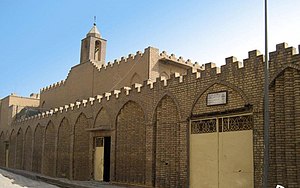Cathedral of Our Lady of Sorrows
Chaldean cathedral in Baghdad, Iraq From Wikipedia, the free encyclopedia
The Cathedral of our Lady of Sorrows, also called Cathedral of Mary Mother of Sorrows, (Arabic: كنيسة أم الأحزان, romanized: Umm al-Ahzan Church) is a Chaldean Catholic cathedral located in Baghdad, Iraq, dedicated to Our Lady of Sorrows.[1] Consecrated in 1898, it is the seat of the Chaldean Catholic Patriarchate of Babylon of the Chaldean Catholic Church, an Eastern Catholic particular church sui iuris in full communion with the Holy See in Rome, and the rest of the worldwide Catholic Church.[2]
| Cathedral of Our Lady of Sorrows | |
|---|---|
Arabic: كنيسة أم الأحزان | |
 Cathedral of Our Lady of Sorrows in Baghdad. | |
 | |
| 33.338139°N 44.395528°E | |
| Location | Baghdad, Iraq |
| Denomination | Chaldean Catholic Church |
| History | |
| Founded | 1843 |
History

The cathedral was first built in 1843 due to the growing community of Chaldean Christians in the Shorja area as a primitive build but the building was later rebuilt in a larger cathedral that could sit around 2,000 people. The Church is built in Iraqi architecture and includes terracotta materials. Due to its low area, the Church was flooded several times and its floor was rebuilt to be 5 meters higher in 1889. During World War II, Polish Soldiers helped craft the Church's high altar.[2] The Church of Umm Al-Ahzan is considered a destination for all sects, even non-Christians, as people go to it to fulfill their needs and make vows in it.[3]
Due to the increasing acts of violence against Christians after the fall of Saddam Hussein's regime, more and more Christians left the city, and around 2018 only about 120 Christian families lived in the Aqd al-Nasara district. Only a few events and services are now being held in the building. Nevertheless, the church was restored and renovated in 2015 under Patriarch Louis Raphael I Sako.[2]
Architecture
The cathedral is built in Iraqi architecture, which other churches in Baghdad are also built in. The walls of the building are very thick which helps keeping in coolness in the summer and heat in the winter and some of the inscriptions in Arabic and French. The outside walls adorned are with bas-relief using bricks, representing ancient crosses, and other religious ornaments. There are many doors that lead to the inside which includes pillars and arches in Mosul marble which were carried to Baghdad using the Tigris river.[2]
References
External links
Wikiwand - on
Seamless Wikipedia browsing. On steroids.
